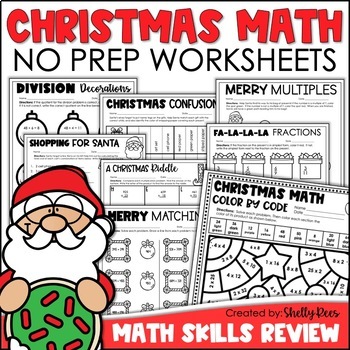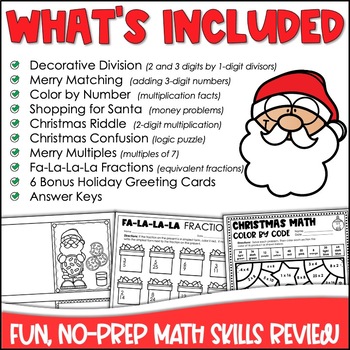Christmas Math Worksheets | Christmas Multiplication and Division Activities
- PDF
What educators are saying
Description
These Christmas Math Worksheets for Grades 4-6 are perfect for a busy time of year! The NO PREP Christmas Math Activities in this packet are a great way to keep your students happy while reviewing important math skills.
Please click on the PREVIEW button above to get a closer look at this resource.
This packet is completely different than my Christmas Reading and Math Packet.
This fun, academically-aligned, no prep Christmas math worksheets packet includes:
- Decorative Division (Long Division by 1-Digit Divisors)
- Multiplication Color by Number (Multiplication Facts)
- Merry Matching (3-Digit Addition)
- Christmas Confusion (Logic Puzzle)
- Merry Multiples (Identifying Multiples)
- Christmas Riddle Time (2-Digit Multiplication)
- Fa-La-La-La Fractions (Simplifying Fractions)
- Shopping for Santa (Money)
- Bonus: 6 Printable Christmas Cards (Coloring Activity)
- Answer Keys
Your students will love the fun approach to learning around the holidays, and you will enjoy the ease of planning at this hectic time of year! Simply print and go!
If you like this packet, be sure to check out my other Christmas resources:
December Reading/ELA Unit-Christmas Informational Text, Center Games, Writing Activities, & More!
Christmas Writing Task Cards - Common Core Aligned
Christmas Reading and Math Packet
Christmas Reading and Math Packet
Christmas Calendar Gift Print and Color Packet
Don't forget that leaving feedback earns you points toward FREE TPT purchases. I strive for perfect feedback. . . it's so rewarding!
Also, FOLLOW ME and be notified when new products are uploaded. New products are always 50% off for the first 24 hours they are posted. It pays to follow me!
Please feel free to contact me with any questions.
Thank you so much,
Shelly Rees





